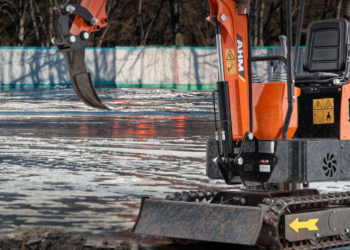Are you considering going solar but aren’t quite sure how to get started? One of the key components of any solar energy system is the mounting structure that holds your panels in place.
With so many options on the market, deciding which one is right for you can be overwhelming.
In this blog post, we’ll explore different types of solar panel mounting and help you determine which option might work best for your home or business.
So let’s dive into solar panel mounting and discover what makes each style unique!
Choosing the Right Solar Panel Mount for Your Needs
Exploring solar panel mounting can be valuable in understanding how well a solar system will perform. The structure of a building and local weather conditions may necessitate certain types of devices better suited to a given circumstance.
Some solutions use roof mount devices, which are often best for flat roofs, while other solutions may be designed for ground mounting, allowing for the positioning of solar panels to get the maximum amount of solar exposure. It is important to consider the cost and safety of the solution when selecting a solar panel mounting device.
It may also be advantageous to consider the aesthetic of the installation. A worn panel mounting device can detract from the overall look of the structure. Choosing the right mount can save time and money, as well as maximize the efficiency of the solar system.
Once you’ve taken all of these factors into account, you can start looking at different mounts. From there, see which one will work best for your needs. If you want to get a better understanding, solar panel installers can help you check it out.
Types of Solar Panel Mounts
Solar panel roof mounts are an integral part of exploring solar energy as an alternative to traditional power sources. Depending on the type of roof, there are a variety of roof mounts available.
Here are four types of Mount:
Roof Mounts
A Sola Panel Roof Mount is a type of mount used to attach solar panels to a roof. It is designed to allow for the safe and easy installation of photovoltaic modules. This is for residential and smaller commercial applications.
The mount attaches to the roof deck usually through a metal bracket, allowing for an adjustable pitch to be applied when installing. Sola Panel Roof Mounts are commonly used because they allow for long-term safe and secure attachment.
It is as well as easy replacement or adjustment of the panel should the need arise. They also provide a range of different mounting options depending on the type of roof, making them an ideal choice for both homes and businesses.
Ground Mounts
Solar panel ground mounts are an effective and reliable way to securely mount solar panels. It is important to make sure they are securely attached to the ground so that they are well supported and can weather strong winds and other harsh weather.
Ground mounts are the most common and most cost-effective way to do this. Ground mounts can be placed either vertically, angled, or flat against the ground, depending on the structure of the panel and its surrounding environment.
Ground mounts are typically made of steel or aluminum, and can be adjusted to tilt the panel at the optimal angle for maximum solar exposure. There are a variety of mounting systems available.
It is important to choose one that is suitable for the specific type of solar panel and its surrounding environment. Ground mounts provide an effective way to ensure that solar panels are securely held in place and can withstand inclement weather.
Pole Mounts
Pole mounts are a popular choice for mounting solar panels, making them quick and easy to install. Solar panel pole mounts provide excellent security as well as a secure base for mounting a solar array.
They are also cost-effective, making them an attractive option for both commercial and residential projects. Pole mounts provide total coverage for the panels so that no part is exposed to the elements, which increases their overall efficiency.
They are also extremely adjustable and are suitable for angled, tilted, and flat installations. This makes them a great choice for a variety of locations. Pole mounts also offer flexibility in that they can easily be adjusted to accommodate ever-changing shade trees and new buildings.
Tracking Mount
A tracking mount for solar panels is a revolutionary product that allows solar panel users to get more energy at a lower cost. A tracking mount is a device specifically designed to maximize the amount of energy received from sunlight.
It tracks the sun as it moves throughout the day. The solar panel is mounted on this device, and connected to a motor that rotates the panel to constantly keep the panel pointed towards the sun’s rays.
This method increases the amount of energy produced and reduces the costs for users that would normally pay for more solar panels to receive the same amount of energy.
The tracking mount also takes the guesswork out of mounting multiple solar panels, allowing for simple and easy solar panel installation. Investing in a tracking mount is a great way to save money and receive more energy from solar panels.
The Process of Installing a Solar Panel Mount
The process of installing a solar panel mount is relatively straightforward but requires some prior knowledge of solar energy and photovoltaic systems. The first step is to pick the right location and mounting option.
Find an Area with Enough Sunlight
Finding an area with enough sunlight is an important part of installing a solar panel mount. This spot should be free from trees, buildings, and other structures that might block the panel from direct sunlight. Next, the mount must be properly positioned.
This can be done by using a bubble or magnet level to ensure that it is mounted perfectly perpendicular to the ground. Once the correct angle is found, the mount should be bolted to the surface to make sure it does not move over time.
The solar panel itself must be connected to the mount and bolted in place. At this point, the solar panel is ready to begin collecting sunlight and providing renewable solar energy.
Attach Solar Panel Mounts Securely
The process of installing a solar panel mount begins with preparing the area where it needs to be installed, as well as preparing any existing infrastructure.
This may include cutting away existing roof shingles, hammering holes in concrete, or using connecting plates for additional security. The appropriate mounting components need to be secured before proceeding.
After that comes attaching the solar panel mounts securely. This is done by first positioning the mounts on the prepared surface with the correct angle and orientation to achieve the most effective results.
Drilling bolts through the mount will then hold the mount in place. For the mount to be securely attached, special self-tapping screws and sealant should be used to reduce any risk of vibration or leakage.
Follow the Solar Panel Proper Installation Techniques
When installing a solar panel mount, it is important to follow the solar panel proper installation techniques. It is essential to read the instruction manual and research the requirements of the mounting system before beginning.
The mounting site needs to be leveled and secured before installing any of the mounting materials. Depending on the system being used, the panels may need to be wired together and connected to the system’s inverter before installation.
During the installation, it is essential to ensure the panels are aligned correctly and tighten the mounting bolts to secure the panel mounts securely.
Further steps might include wiring the panels together with other mechanisms and connecting the system components, such as cables and connectors.
Proper Wiring Connection
To properly install a solar panel mount, the first step is to make sure all components are accounted for and securely tightened. Next, the mounting frame should be secured to the appropriate location using concrete, steel bolts, or other appropriate connectors.
Once the frame is in place, the module can be attached to the mounting frame. All wiring connections should then be tested for proper voltage and resistance to ensure they are in the correct range.
Once the power equipment is assembled, the panel mount should be attached to the frame with all wiring tied down. Finally, the solar panel should be properly affixed to the mounting frame, and all the required disconnect boxes labeled and installed.
Following these steps will properly and safely install the solar panel mount and ensure proper wiring connections are in place.
Ensure Quality Installation
This includes finding an area with enough sunlight and an appropriate amount to accommodate the local weather conditions of the area. Once the location and mounting options have been determined, the next step is to attach the solar panel mounts securely to the roof.
Following proper installation techniques based on panel size and weight is critical. Once the mount is secured, the solar panels can be attached to the mount and wired appropriately.
Once the system is wired, the solar panels need to be properly grounded and each panel should be connected via the corresponding junction box.
Finally, the main power inverter can be attached and the installation is complete. Ensuring a quality installation is paramount to the successful operation of a solar energy system.
Know the Benefits of Solar Panel Mounting
Solar panel mounting is an option for those wishing to install solar panel systems to reduce their carbon footprint and save money on their electricity bills. Here are the key benefits of using a Solar Panel Mount:
Increased Efficiency
The installation of solar panel mounting is widely seen as a big contributor to increased efficiency in solar energy collection and harvesting. Its no-drill design helps keep the panels from being damaged.
It gives them extra protection from harsh winds and weather. The mounting can also be adjusted to the appropriate angle to maximize efficiency, by tracking the ideal direction to receive the most sunlight throughout the day.
The mounting is designed to facilitate easier installations, often resulting in time and money savings in the long run. Furthermore, more reliable connections can be made to wire up an entire solar system using mounts, as opposed to cable ties and/or clamps.
Protection from the Elements
Solar panel mounting is the most important step in the installation of a solar panel system. It provides support for the hardware and gives it the stability required for proper functioning. Mounting protects us from the elements.
This keeps the solar panels safe from the wind and rain. It also guards solar panels against physical and chemical damage, ensuring their optimal performance.
Mounting a solar panel system in a high location like the roof prevents debris and other objects from blocking the sun’s rays. It also allows the system to receive maximum exposure, ensuring maximum efficiency and increased energy production.
Mounting allows for better air circulation and cooling of the system, thus increasing the lifespan of the solar panels.
Enhanced Esthetics
Solar panel mounting provides many benefits to enhance esthetics in a variety of settings. In residential settings, the solar array can be tilted. It can also be adjusted for optimum sun exposure.
This is without blocking views or overwhelming the building’s design. In commercial buildings, the mounting system can be designed. This is to follow the contours of an angled roof. It can be tailored to integrate into the building’s architecture.
This creates an attractive and cohesive look. Choose mounting components, such as mounting rails and anodized aluminum. It also provides additional decorating options. This includes painting, printing, or adding accents.
Increased Safety
Solar panel mounting can offer increased safety when installed correctly. It is important that the mounting is set up correctly to prevent accidents or property damage. Solar panel mounting provides structural support and stability.
This prevents the panel from becoming dislodged while in use. This prevents any debris from flying off or the panels from swaying in high-wind conditions. Solar panel mounting also mitigates any damage.
This could occur from either extreme weather or seismic activity. Solar panel mounting also increases safety by protecting it from electric shock.
Common Mistakes to Avoid When Installing a Solar Panel Mount
Installing a solar panel mount can be a tricky process, but there are a few common mistakes that you can avoid to make the process easier. First, be sure to measure the area where you want to install the mount before purchasing it.
It is important to get the amount that is the right size for your needs. Second, be sure to follow the instructions that come with the support carefully. This will help you avoid any potential problems.
Be sure to check the mounts regularly to ensure they are secure and do not cause any damage to your roof or home.
Explore Solar Panel Mounting Starting Today
We’ve seen that choosing the right solar panel mounting system can make all the difference. This is in maximizing solar panel power output. Explore your options with professionals who understand solar panel technology.
This will help you take full advantage of the solar power your home or business can generate. Contact us today to find out more!







